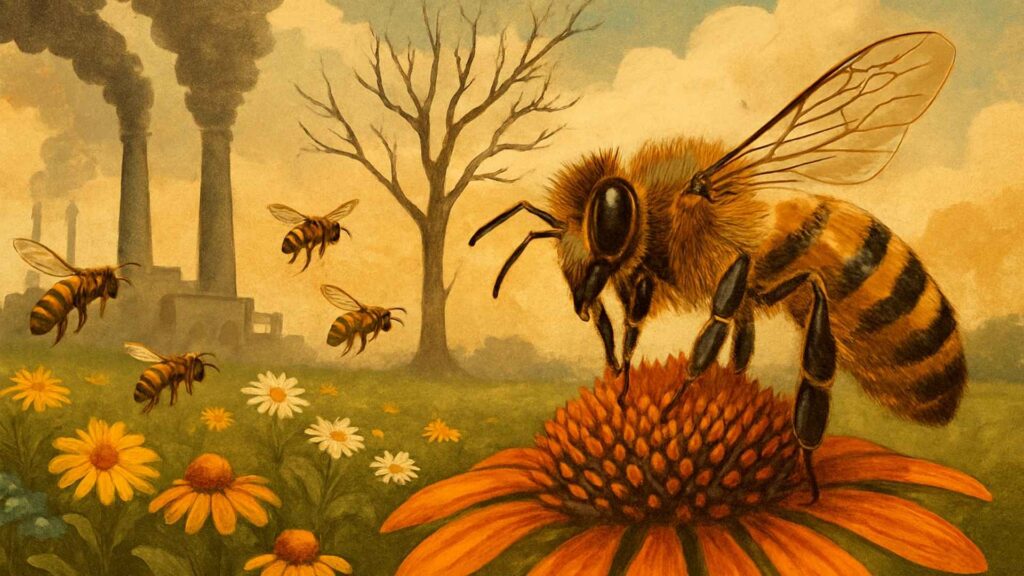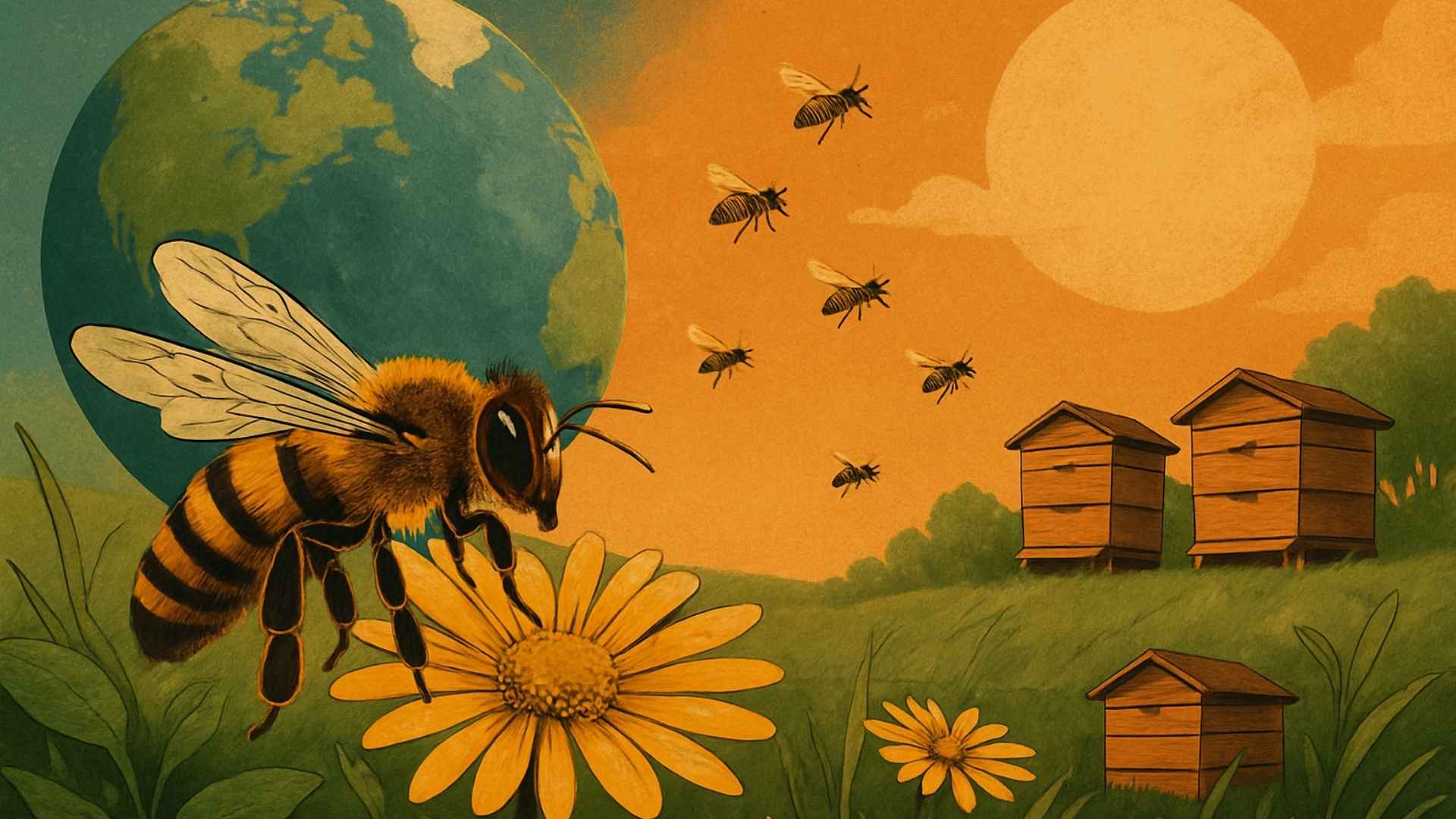Why Bees Are Disappearing and What It Means for Our Planet
Bees Are Disappearing – Bees are vital pollinators, responsible for sustaining global ecosystems and agriculture. Yet, bee populations are facing an unprecedented decline, posing severe risks to biodiversity, food security, and the global economy. This article explores the causes of bee disappearance, its staggering impact on food production, and the urgent need to protect these indispensable insects.
Why Bees Are Disappearing- Unpacking the Causes
1. Pesticides and Chemical Exposure
- Pesticides, especially neonicotinoids, are a major factor causing bee mortality.
- Research shows some pesticides act synergistically, making their combined effects on bees worse than when acting alone.
- Pesticides disrupt bees’ navigation, immunity, and reproduction, significantly weakening colonies.
2. Parasites and Diseases
- The Varroa destructor mite is the deadliest parasite affecting honeybees globally.
- It not only feeds on bee blood but also transmits viruses that contribute to colony collapse disorder (CCD).
- Other pathogens like Nosema fungi also degrade bee health.
3. Habitat Loss and Reduced Floral Resources
- Intensive agriculture, urban sprawl, and deforestation reduce natural habitats.
- Loss of flower-rich meadows and nesting sites leaves bees with limited forage.
- Monoculture farming limits floral diversity, causing poor nutrition and increased stress.
4. Climate Change
- Rising temperatures and extreme weather events disrupt bee life cycles and flowering patterns.
- About 65% of bees face a decrease in suitable habitat due to climate shifts.
- Climate change may extend autumn flying seasons but paradoxically increase spring colony collapse risk.
5. Colony Collapse Disorder
- CCD involves sudden disappearance of worker bees with few dead bees found nearby.
- Approximately 50% of affected colonies show symptoms not fully explained by known causes.
- It remains a complex phenomenon linked to multiple stressors acting together.

Alarming Facts & Figures on Bee Decline
- Washington State University projects a 60-70% decline in U.S. honeybee colonies in 2025.
- From June 2024 to February 2025, the U.S. lost 62% of commercial beehives, the worst ever recorded.
- Over the past 15 years, annual colony losses averaged 40%, far exceeding the acceptable loss rate of 15-20%.
- Despite losses, the U.S. has added nearly 1 million colonies in the last five years, totaling 3.8 million colonies.
Why Bees Matter: Impact on Food Production and Economy
1. Pollination Powerhouse
- Bees and other pollinators contribute to 35% of global crop production.
- Around one-third of the human diet depends on bee-pollinated crops, including fruits, nuts, vegetables, and seeds.
- Animal-based pollination accounts for 30% of global food production.
2. Economic Value
- Pollination services are valued at over $125 billion annually worldwide.
- In the U.S., pollination contributes an estimated $20-30 billion to agriculture.
- Loss of pollinators threatens to increase food prices and jeopardize farmer incomes globally.
3. Food Security
- Studies predict that without pollinators, crop yields could drop by 5% in high-income countries and 8% in low- to middle-income countries.
- Reduced pollination undermines biodiversity, leading to fewer wild plants and disrupted ecosystems.
- This creates a cascading effect, threatening animals dependent on those plants and increasing risks of hunger worldwide.
Must Read: Town Where It is Illegal to Die
What Can Be Done? Solutions to Save Bees
1. Reduce and Regulate Pesticide Use
- Limit use of harmful chemicals like neonicotinoids.
- Promote bee-friendly pest management and organic farming.
2. Restore and Protect Habitats
- Encourage planting of native wildflowers, shrubs, and trees.
- Protect natural meadows, forests, and green spaces to provide forage and nesting sites.
3. Support Sustainable Agriculture
- Promote crop diversity and reduce monocultures.
- Implement cover cropping and agroecological practices that benefit pollinators.
4. Research and Monitoring
- Fund studies on bee health, disease, and climate resilience.
- Develop early warning systems for colony collapse and improve bee management.
5. Public Awareness and Policy
- Educate communities on the importance of pollinators.
- Push for stronger environmental policies that protect bees and their habitats.
Unique Bee Facts
- There are over 20,000 species of bees worldwide, not just honeybees.
- A single bee can visit up to 5,000 flowers per day.
- Bees communicate the location of flowers to hive mates through the famous “waggle dance”.
- Bee pollination increases crop yields not only in quantity but also in quality, improving fruit size, taste, and shelf life.
Conclusion
The sharp decline of bees is a clear signal of environmental distress with serious consequences for our planet’s health and our food systems. Immediate, coordinated efforts to tackle the multiple causes of bee decline are essential. By protecting bees, we safeguard biodiversity, secure food production, and promote a sustainable future for all.








One Comment